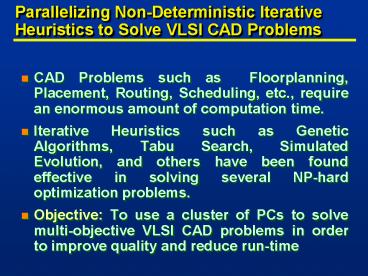Parallelizing Non-Deterministic Iterative Heuristics to Solve VLSI CAD Problems PowerPoint PPT Presentation
Title: Parallelizing Non-Deterministic Iterative Heuristics to Solve VLSI CAD Problems
1
Parallelizing Non-Deterministic Iterative
Heuristics to Solve VLSI CAD Problems
- CAD Problems such as Floorplanning, Placement,
Routing, Scheduling, etc., require an enormous
amount of computation time. - Iterative Heuristics such as Genetic Algorithms,
Tabu Search, Simulated Evolution, and others have
been found effective in solving several NP-hard
optimization problems. - Objective To use a cluster of PCs to solve
multi-objective VLSI CAD problems in order to
improve quality and reduce run-time
2
Approach To employ a Cluster of PCs to
Distribute Computationally Intensive Tasks
- Clusters of low end PCs are easy to build.
- Tools such as MPI and PVM are available for
message passing. - Tools such as gprof, Intels VTUNE Performance
Analyzer, etc., are used for generating profiles
for serial codes and determining the part of the
code that has the bottlenecks. - Iterative algorithms are non-deterministic, and
dividing work load, i.e. partitioning the search
space, is a challenge. - The parallelizing model (i.e., Partitioning,
Communication, Agglomeration and Mapping) is very
well-defined for numerical problems, which are
mostly deterministic. This is not the case for
Iterative heuristics, which are non-deterministic.
3
Publications from this Project
- Sadiq M. Sait, Mustafa I. Ali, Ali Mustafa Zaidi,
Multiobjective VLSI Cell Placement Using
Distributed Simulated Evolution Algorithm, IEEE
International Symposium on Circuits and Systems,
ISCAS, Kobe, Japan, May 2005. - Mahmood R. Minhas, Sadiq M. Sait, A Parallel
Tabu Search Algorithm for Optimizing
Multiobjective VLSI Placement, Intl Conf. on
Computational Science and its Application, May
2005, Singapore, Proceedings published by
Springer-Verlag in Lecture Notes in Computer
Science, LNCS 3483, pp. 587-595. - Sadiq M. Sait, Mohammed Faheemuddin, Mahmood R.
Minhas, Syed Sanaullah, Multiobjective VLSI Cell
Placement using Distributed Genetic Algorithm,
ACM Genetic and Evolutionary Computation
Conference, GECCO, June 2005, Washington DC, USA. - Sadiq M. Sait, Syed Sanaullah, Ali Mustafa Zaidi,
Mustafa I. Ali, Comparative Evaluation of
Parallelization Strategies for Evolutionary and
Stochastic Heuristics, ACM Genetic and
Evolutionary Computation Conference, GECCO, June
2005, Washington DC, USA.
4
Relationship to Intels RD
- COE Department has faculty experienced in VLSI
Design. - A book in the area of iterative algorithms has
been authored by the department faculty. - The Technology Center being proposed in RI will
have the state-of-art tools and equipment. - Faculty and students currently interested in HPC
and parallelization of heuristics can work
together to address industrial and real-world
problems.
5
Tools used in our Current Cluster
- MPICH Library provides a flexible
implementation of MPI for easier message-passing
interface development on multiple network
architectures. - Intel Trace Collector 5.0 applies event-based
tracing in cluster applications with a
low-overhead library. Offers performance data,
recording of statistics, multi-threaded traces,
and automatic instrumentation of binaries on
IA-32. - Intel Trace Analyzer 4.0 provides visual
analysis of application activities gathered by
the Intel Trace Collector. - TotalView (MPICH) is also used for observing
communication between processors. - Also used in Condor (for scheduling jobs on the
cluster).

